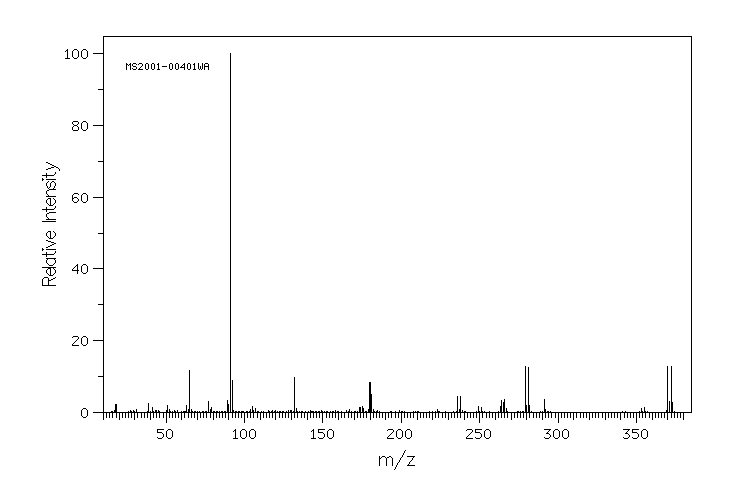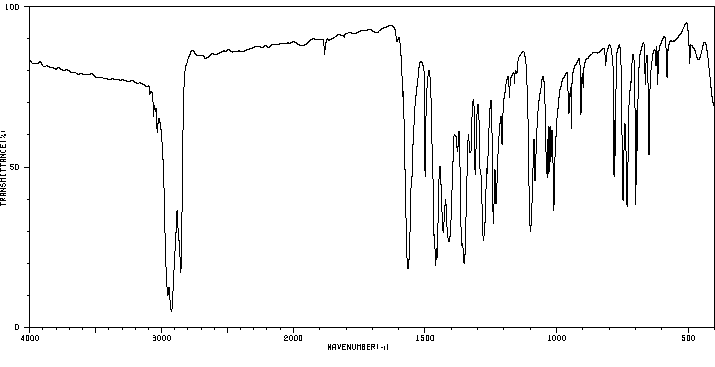5-溴-2,4-二(苯基甲氧基)-嘧啶 | 41244-53-5
中文名称
5-溴-2,4-二(苯基甲氧基)-嘧啶
中文别名
5-溴-2,4-二(苯基甲氧基)嘧啶;2,4-双(苄氧基)-5-溴嘧啶
英文名称
5-bromo-2,4-bis(benzyloxy)pyrimidine
英文别名
2,4-dibenzyloxy-5-bromopyrimidine;5-Brom-2,4-dibenzyloxy-pyrimidin;2,4-bis(benzyloxy)-5-bromopyrimidine;5-bromo-2,4-bis(phenylmethoxy)pyrimidine
CAS
41244-53-5
化学式
C18H15BrN2O2
mdl
——
分子量
371.233
InChiKey
QMPWETJGPVPWGU-UHFFFAOYSA-N
BEILSTEIN
——
EINECS
——
-
物化性质
-
计算性质
-
ADMET
-
安全信息
-
SDS
-
制备方法与用途
-
上下游信息
-
文献信息
-
表征谱图
-
同类化合物
-
相关功能分类
-
相关结构分类
物化性质
-
熔点:88-90 °C(Solv: ethanol (64-17-5))
-
沸点:517.4±60.0 °C(Predicted)
-
密度:1.419±0.06 g/cm3(Predicted)
计算性质
-
辛醇/水分配系数(LogP):4.5
-
重原子数:23
-
可旋转键数:6
-
环数:3.0
-
sp3杂化的碳原子比例:0.11
-
拓扑面积:44.2
-
氢给体数:0
-
氢受体数:4
安全信息
-
海关编码:2933599090
-
危险性防范说明:P261,P280,P305+P351+P338
-
危险性描述:H302,H315,H319,H332,H335
-
储存条件:存储条件:室温、干燥且密封。
SDS
上下游信息
-
下游产品
中文名称 英文名称 CAS号 化学式 分子量 2,4-二苄氧基嘧啶-5-硼酸 5-(dihydroxyboryl)-2,4-bis(benzyloxy)pyrimidine 70523-24-9 C18H17BN2O4 336.155 —— 2,4-dibenzyloxy-5-trimethylsilylpyrimidine 62803-28-5 C21H24N2O2Si 364.519
反应信息
-
作为反应物:描述:参考文献:名称:Synthesis of Pyrrolidine C-Nucleosides via Heck Reaction摘要:[GRAPHICS]A novel method for the synthesis of pyrrolidine C-nucleosides has keen developed, The key step of the synthesis is the palladium(0)-mediated coupling of a disubstituted N-protected 2-pyrroline and 5-iodouracil. C-Nucleoside 14 and its N-methyl derivative 15 can easily be convened to the corresponding phosphoramidite building blocks for DNA synthesis.DOI:10.1021/ol007029s
-
作为产物:描述:5-溴-2,4-二氯嘧啶 在 sodium hydride 作用下, 以 甲苯 为溶剂, 反应 1.0h, 以73.3%的产率得到5-溴-2,4-二(苯基甲氧基)-嘧啶参考文献:名称:WO2007/125061摘要:公开号:
文献信息
-
Synthesis of 5-fluorovinyl derivatives of pyrimidines via Suzuki–Miyaura coupling and their 1,3-dipolar cycloaddition reactions with nitrones作者:Hanna Wójtowicz-Rajchel、Henryk KoroniakDOI:10.1016/j.jfluchem.2011.11.005日期:2012.3A simple two-step synthesis of a new class of fluorinated isoxazolidinyl derivatives of pyrimidine is described. The reactions proceed via the Suzuki–Miyaura coupling followed by highly regioselective 1,3-dipolar cycloaddition with nitrones. Removal of the pyrimidine protecting groups leads to a fluorinated isoxazolidine analogue of pseudouridine.
-
Inhibitors of bace申请人:——公开号:US20030095958A1公开(公告)日:2003-05-22The present invention relates to inhibitors of aspartic proteinases, particularly, BACE. The present invention also relates to compositions thereof and methods therewith for inhibiting BACE activity in a mammal, and for treating Alzheimer's Disease and other BACE-mediated diseases.
-
一种对称型嘧啶基碘鎓盐及其制备方法申请人:东华大学公开号:CN105237483B公开(公告)日:2018-04-20
-
Diastereoselective Flexible Synthesis of Carbocyclic C-Nucleosides作者:Lukáš Maier、Prashant Khirsariya、Ondřej Hylse、Santosh Kumar Adla、Lenka Černová、Michal Poljak、Soňa Krajčovičová、Erik Weis、Stanislav Drápela、Karel Souček、Kamil ParuchDOI:10.1021/acs.joc.6b02594日期:2017.4.7(in six steps) or optically pure (in ten steps) from inexpensive norbornadiene. The methodology allows flexible manipulation of individual positions around the cyclopentane ring, namely highly diastereoselective installation of carbo- and heterocyclic substituents at position 1′, orthogonal functionalization of position 5′, and efficient inversion of stereochemistry at position 2′. Newly prepared carbocyclic
-
“Molecular Chameleons”. Design and Synthesis of a Second Series of Flexible Nucleosides作者:Katherine L. Seley、Samer Salim、Liang Zhang、Peter I. O'DanielDOI:10.1021/jo048218h日期:2005.3.1The second series of flexible shape-modified nucleosides is introduced. The “fleximers” feature the purine ring systems split into their individual imidazole and pyrimidine components. This structural modification serves to introduce flexibility to the nucleoside while still retaining the elements essential for recognition. As a consequence, these structurally innovative nucleosides can more readily
表征谱图
-
氢谱1HNMR
-
质谱MS
-
碳谱13CNMR
-
红外IR
-
拉曼Raman
-
峰位数据
-
峰位匹配
-
表征信息
同类化合物
(S)-3-(2-(二氟甲基)吡啶-4-基)-7-氟-3-(3-(嘧啶-5-基)苯基)-3H-异吲哚-1-胺
(6-羟基嘧啶-4-基)乙酸
(4,5-二甲氧基-1,2,3,6-四氢哒嗪)
鲁匹替丁
马西替坦杂质7
马西替坦杂质4
马西替坦杂质
马西替坦原料药杂质D
马西替坦原料药杂质B
马西替坦
顺式-4-{[5-溴-2-(2,5-二甲基-1H-吡咯-1-基)-6-甲基嘧啶-4-基]氨基}环己醇
非沙比妥
非巴氨酯
非尼啶醇
青鲜素钾盐
雷特格韦钾盐
雷特格韦相关化合物E(USP)
雷特格韦杂质8
雷特格韦EP杂质H
雷特格韦-RT9
雷特格韦
阿西莫司杂质3
阿西莫司
阿脲四水合物
阿脲一水合物
阿维霉素
阿米美啶
阿米洛利
阿米妥钠
阿洛巴比妥
阿普瑞西他滨
阿普比妥
阿巴卡韦相关化合物B(USP)
阿卡明
阿伐那非杂质V
阿伐那非杂质1
阿伐那非杂质
阿伐那非中间体
阿伐那非
铂(2+)二氯化6-甲基-1,3-二{2-[(2-甲基丙基)硫烷基]乙基}嘧啶-2,4(1H,3H)-二酮(1:1)
钴1,2,3,6-四氢-2,6-二氧代嘧啶-4-羧酸酯(1:2)
钠5-烯丙基-4,6-二氧代-1,4,5,6-四氢-2-嘧啶醇酸酯
钠5-乙基-4,6-二氧代-1,4,5,6-四氢-2-嘧啶醇酸酯
钠5-(2-溴丙-2-烯基)-5-丁烷-2-基-4,6-二氧代-1H-嘧啶-2-醇
醌肟腙
酒石酸噻吩嘧啶
那可比妥
辛基2,6-二氧代-1,2,3,6-四氢-4-嘧啶羧酸酯
赛乐西帕杂质3
赛乐西帕KSM3








